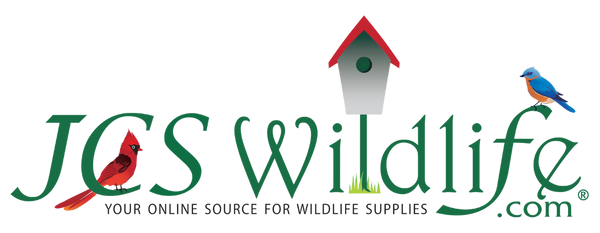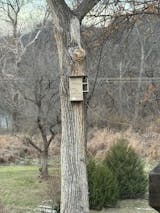Meet the House Finch: A Common Backyard Visitor
If you’ve ever looked out your window and spotted a small, cheerful bird with a splash of red on its head or chest, chances are you’ve met the House Finch. These sociable little songbirds are among the most common backyard birds in North America—and for good reason! They’re adaptable, friendly, and a joy to watch.
In this blog, we’ll dive into everything you need to know about House Finches: their appearance, nesting habits, diet, behaviors, and how to attract them to your yard. Whether you're a seasoned birder or just getting started, this guide will help you appreciate these feathered friends even more.

1. What Does a House Finch Look Like?
House Finches are small birds, about 5 to 6 inches long, with a wingspan of 8 to 10 inches. Males are easy to spot thanks to their rosy-red foreheads, throats, and chests. The rest of their body is streaked brown and white. Females, on the other hand, are more modestly dressed in brown and white streaks with no red coloring.
Their beaks are short and conical—perfect for cracking seeds—and their tails are slightly notched. If you’re trying to identify a House Finch at your feeder, look for that red splash and listen for their cheerful, warbling song.

2. Where Do House Finches Live?
Originally native to the western United States and Mexico, House Finches have spread across the country and are now found coast to coast. They thrive in urban, suburban, and rural areas alike. You’ll find them in city parks, backyards, farms, and even desert areas.
They’re not shy about living near people, which makes them one of the most common birds seen at backyard feeders.

3. Nesting Habits of the House Finch
House Finches are creative nesters. They’ll build their nests in trees, shrubs, hanging planters, building ledges, and even in wreaths on your front door! Their nests are made from twigs, grasses, feathers, and other soft materials.
The female does most of the nest building and will lay 2 to 6 eggs per clutch. She incubates the eggs for about two weeks, and once hatched, both parents help feed the chicks. House Finches can raise multiple broods in a single season, especially in warmer climates.

4. What Do House Finches Eat?
House Finches are primarily seed eaters. Their favorite foods include:
- Black oil sunflower seeds
- Safflower seeds
- Millet
- Sunflower hearts
- Nyjer (thistle) seed
- Cracked corn
- Fruit (like berries and apples)
They’ll also nibble on buds, flowers, and the occasional insect. If you want to attract House Finches to your yard, a tube feeder filled with sunflower or Nyjer seed is a great start. They’re not picky eaters, but they do love a consistent food source.

5. House Finch Behavior: Social and Sweet
House Finches are social birds. You’ll often see them in small flocks, especially outside of the breeding season. They’re not aggressive and tend to get along well with other birds at feeders.
Their song is a cheerful, warbling tune that’s easy to recognize once you’ve heard it a few times. Males sing to attract mates and to mark their territory. During courtship, a male may even feed the female as part of his romantic gesture.

6. How to Attract House Finches to Your Yard
Want to make your yard a House Finch haven? Here are a few tips:
- Use the right feeder: Tube feeders with small perches are ideal.
- Offer their favorite seeds: Black oil sunflower and nyjer seed are top choices.
- Provide fresh water: A birdbath or shallow dish of water can be a magnet.
- Plant native shrubs and flowers: These provide natural food and shelter.
- Avoid pesticides: Keep your yard bird-safe by going chemical-free.
Once they find your feeder, House Finches are likely to return again and again.

7. Common Questions About House Finches
Q: Are House Finches good for the garden?
A: Yes! They help control weed populations by eating seeds and may also snack on small insects.
Q: Do House Finches migrate?
A: Most House Finches are year-round residents, especially in warmer areas. Some northern populations may move south in winter.
Q: Are House Finches aggressive?
A: Not usually. They’re one of the more peaceful birds at feeders and tend to coexist well with others.
Q: Why is my House Finch losing feathers around its eyes?
A: This is often due to avian mites, or a condition called finch eye disease (Mycoplasmal conjunctivitis). It’s common and usually not fatal but keeping feeders clean can help prevent its spread.
Q: How long do House Finches live?
A: In the wild, House Finches typically live 4 to 5 years, though some have been known to live over 10 years in ideal conditions.
Q: Can I feed House Finches fruit or kitchen scraps?
A: Yes! They enjoy soft fruits like berries, apples, and bananas. Avoid anything salty, sugary, or processed.
Q: Do House Finches return to the same nesting spot?
A: They often do! If they had a successful brood, they may reuse the same site or build a new nest nearby.
8. House Finch vs. Purple Finch: What’s the Difference?
These two birds are often confused, but there are a few key differences:
- House Finch: Males have a red forehead and chest, with brown streaks on the belly.
- Purple Finch: Males are more raspberry-colored all over, with less streaking.
Purple Finches are also less common and tend to prefer forested areas, while House Finches are more urban-friendly.

9. Fun Facts About House Finches
- Colorful Diet: The red coloring in male House Finches comes from carotenoids in their food. The more fruit and colorful seeds they eat, the brighter their feathers!
- City Slickers: House Finches are one of the few bird species that have adapted extremely well to urban environments.
- East Coast Immigrants: They were originally only found in the western U.S. but were introduced to Long Island, NY, in the 1940s. From there, they spread rapidly across the East.
- Romantic Feeders: During courtship, males often feed females as part of their bonding ritual.
- Fast Builders: A House Finch can build a nest in just a few days, especially if materials are readily available.
- Big Families: They can raise up to 6 broods in a single breeding season in warmer climates.
- Singing Stars: Males have a long, warbling song that can include mimicry of other birds.
- Not Just Red: In rare cases, male House Finches can appear orange or yellow instead of red, depending on their diet.
- Feeder Favorites: They’re among the top 5 most common birds reported in citizen science projects like the Great Backyard Bird Count.
- Eye Disease Awareness: House Finches helped scientists track the spread of conjunctivitis in wild bird populations, making them important in avian health research.
10. Final Thoughts: Why We Love House Finches
House Finches are the kind of birds that make birdwatching fun and accessible. They’re easy to attract, pleasant to watch, and full of personality. Whether you’re filling your first feeder or you’ve been birding for years, these little red-chested charmers are sure to brighten your day.
So next time you see a House Finch at your feeder, take a moment to enjoy its song, its color, and its company. And if you’re looking to stock up on the best bird seed, feeders, or birding gear, check out our [wildlife store name]—we’ve got everything you need to keep your feathered friends happy.



